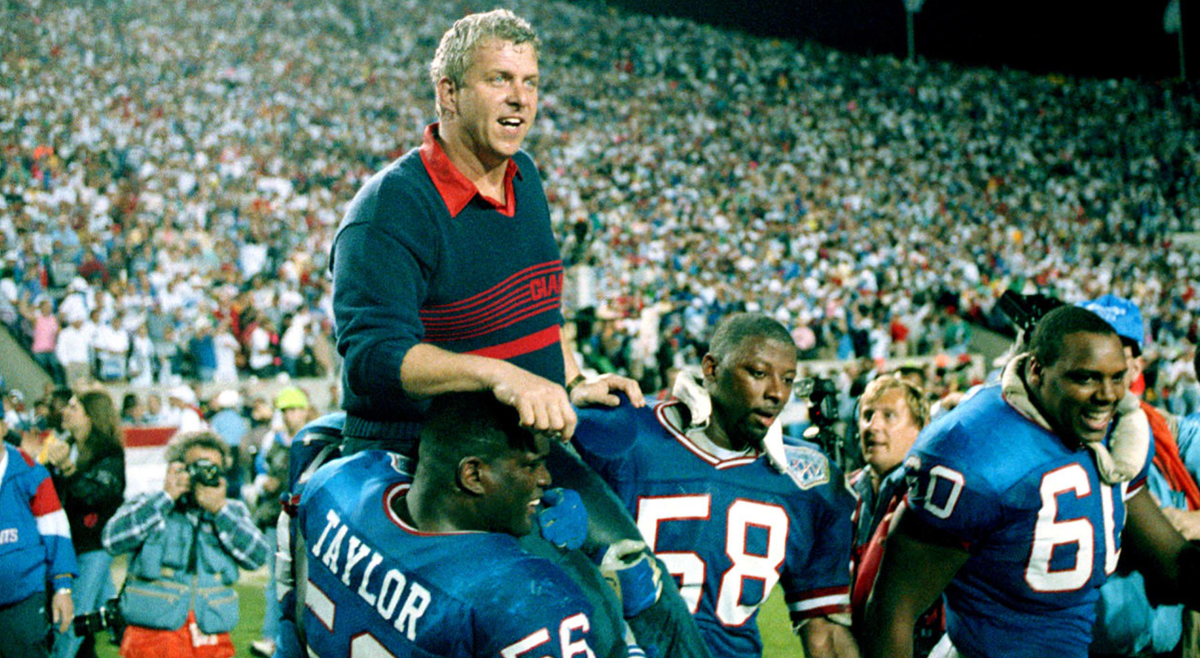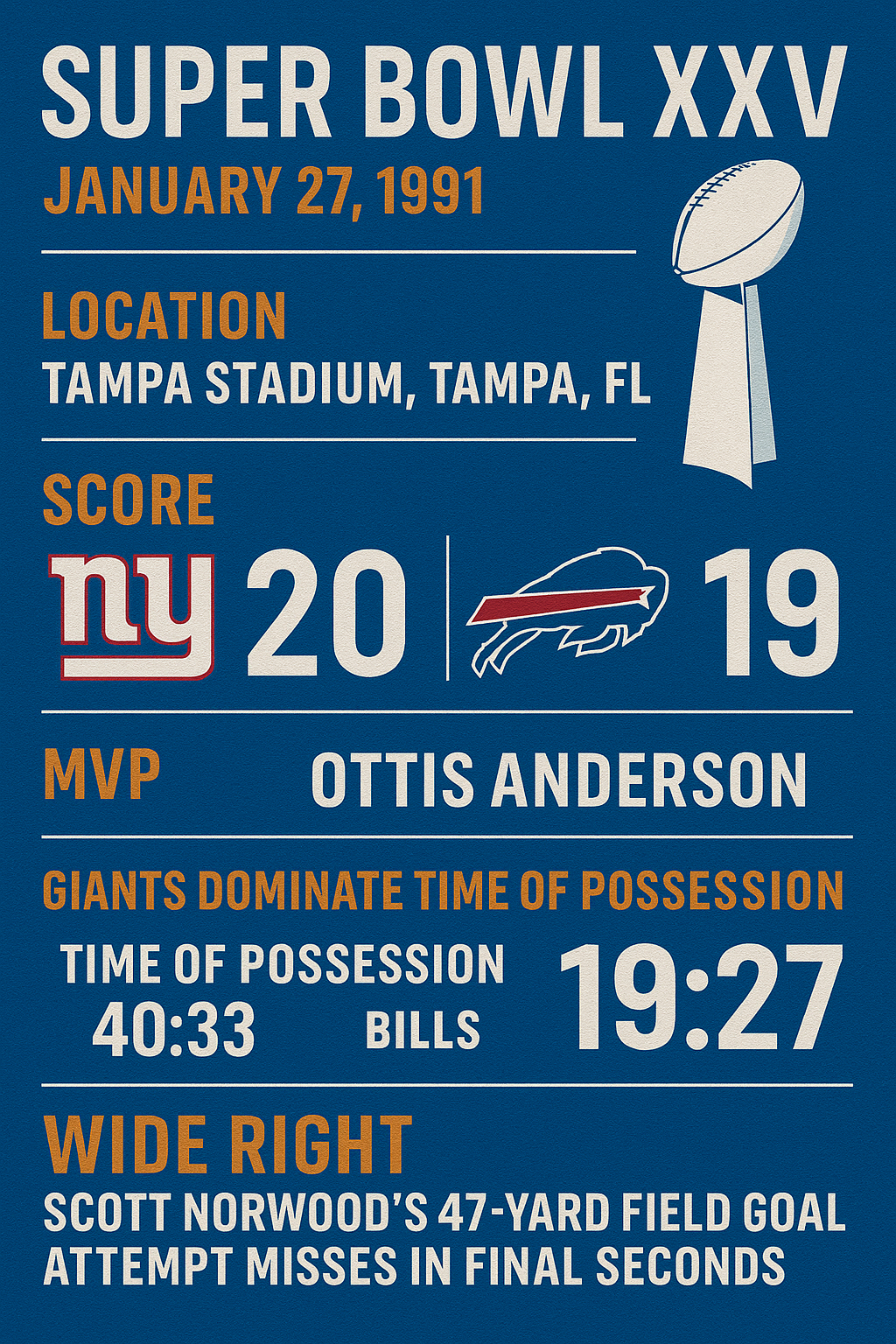Super Bowl XXV: A War-Era Classic Defined by Inches and Intensity

On January 27, 1991, as U.S. troops launched Operation Desert Storm in the Persian Gulf, a very different kind of battle unfolded at Tampa Stadium in Florida. Super Bowl XXV—the 25th edition of America’s biggest sporting event—was played under the shadow of war but became one of the most thrilling and emotionally charged games in NFL history. The matchup featured the Buffalo Bills, boasting the league’s most explosive offense, and the New York Giants, known for their hard-nosed defense and clock-draining offense.
The final score: Giants 20, Bills 19.
But it wasn’t just the margin of victory that made this game unforgettable. It was how it ended—with Buffalo kicker Scott Norwood’s 47-yard field goal attempt sailing wide right in the final seconds. It was heartbreak, strategy, and grit, all distilled into four quarters and a single fateful kick.
Context: A Nation and a Game Under Pressure
Few Super Bowls have felt the weight of the moment quite like this one. As Patriot missiles intercepted Iraqi Scud rockets halfway across the globe, the pregame atmosphere was sober and reflective. Whitney Houston’s rendition of the National Anthem, backed by a military flyover, became iconic. Her performance captured the anxious spirit of the country and set a solemn tone for the game ahead.
“Super Bowl XXV wasn’t just a championship—it was national therapy,” said Dr. Leonard Brooks, senior historian at the Super Bowl Historical Society. “You had two classic franchises, and an audience in the tens of millions craving something to rally behind.”
This was Buffalo’s first trip to the Super Bowl, with a young and dynamic core featuring quarterback Jim Kelly, running back Thurman Thomas, and wide receiver Andre Reed. Under head coach Marv Levy, the Bills ran a revolutionary no-huddle offense that kept defenses off balance.
The Giants, meanwhile, were in their second Super Bowl under head coach Bill Parcells, having won Super Bowl XXI four years earlier. This time, they were led by backup quarterback Jeff Hostetler, who took over late in the season after Phil Simms broke his foot. The Giants leaned heavily on a bruising run game and the league’s top-ranked defense, coordinated by a young Bill Belichick.
The Giants’ Game Plan: Possess and Punish
The Giants came into the game as underdogs, especially against the Bills’ lightning-fast offense. But Bill Parcells and Belichick devised a brilliant strategy: keep the ball out of Jim Kelly’s hands. That meant long, grinding drives, third-down conversions, and conservative play-calling. The Giants executed that plan masterfully.
New York controlled the ball for a Super Bowl record 40 minutes and 33 seconds. They didn’t blitz much. Instead, Belichick’s defense dropped back into coverage, forcing Kelly to throw underneath and take short gains. They hit hard, tackled surely, and never allowed the Bills to break into their typical rhythm.
“This game was a coaching clinic,” said Marie Stetson, a tactics analyst for the Super Bowl Historical Society. “Belichick and Parcells flipped the script on a team that had steamrolled its way through the AFC.”
First Half: Trading Blows
The Bills struck first with a 23-yard field goal by Scott Norwood, capping a drive that showcased Kelly’s versatility. But the Giants responded in the second quarter with a 1-yard touchdown run by Ottis Anderson, their workhorse back, and took a 10–3 lead.
Buffalo didn’t flinch. They responded with their signature tempo and scored twice before halftime—a 1-yard touchdown run by Don Smith and a 38-yard field goal by Norwood—to take a 12–10 halftime lead.
It was already shaping up to be a classic: close, tactical, and physical.
Third Quarter: Methodical Domination
The third quarter belonged to the Giants. Their opening drive was a 14-play, 75-yard masterpiece that consumed over nine minutes—the longest scoring drive in Super Bowl history at the time. Anderson pounded the ball on the ground while Hostetler kept the chains moving with smart, high-percentage passes.
The drive ended with a 9-yard touchdown pass to Stephen Baker, giving the Giants a 17–12 lead.
On the ensuing possession, the Bills quickly reminded the world why they were the AFC’s top offense. Thurman Thomas—who would finish with 135 rushing yards, a touchdown, and nearly win MVP honors—broke off a 31-yard touchdown run. Buffalo reclaimed the lead at 19–17 heading into the fourth quarter.
Fourth Quarter: The Final Stretch
The Giants answered with a clutch drive early in the fourth quarter, setting up Matt Bahr for a 21-yard field goal. It was now 20–19, and tension gripped the stadium.
With 2:16 remaining, Buffalo took over for one last drive. Jim Kelly led a calm, confident march downfield. A key 11-yard completion to James Lofton, a scramble, and Thomas’s hard running moved the Bills into field goal range.
With eight seconds left, Buffalo faced a 47-yard field goal attempt from the right hash. Scott Norwood, their veteran kicker, had the game in his hands.
Snap. Hold. Kick… Wide right.
Giants players exploded in celebration. Bills players fell to their knees. It was an unforgettable ending to a game that felt like a championship bout.
Final Score
- New York Giants: 20
- Buffalo Bills: 19
The margin of one point is the smallest in Super Bowl history. The game itself has since been ranked among the top five Super Bowls of all time by many analysts.

MVP: Ottis Anderson
While Norwood’s miss is often the most remembered moment, Ottis Anderson’s performance was key to New York’s victory. He carried the ball 21 times for 102 yards and a touchdown, consistently converting key downs and breaking tackles to keep drives alive.
The Giants' ball-control offense relied entirely on Anderson’s ability to churn out tough yards, and he delivered when it mattered most.
Coaching Genius: Parcells and Belichick
Few Super Bowls showcase coaching brilliance the way XXV does. Parcells controlled the tempo, trusted his backup quarterback, and leaned on his veteran running back. Belichick, meanwhile, put together a defensive blueprint that would later become foundational in his Hall of Fame career.
The Giants’ ability to bend without breaking, to keep Buffalo's speed in check, was a credit to their preparation and discipline.
This game became required viewing for future coaches on how to counter a superior offense with time of possession and defensive spacing.
Buffalo’s Heartbreak—and Beginning of a Run
For the Bills, Super Bowl XXV was a tragedy—but also a beginning. They would return to the next three Super Bowls (XXVI, XXVII, XXVIII), becoming the only team to appear in four consecutive Super Bowls. Yet they would lose them all.
Still, the 1990 Buffalo Bills remain one of the most talented teams in NFL history. Thurman Thomas, Jim Kelly, Andre Reed, and Bruce Smith are all Hall of Famers. This was a team that redefined offensive football—and left behind a legacy far deeper than the “wide right” narrative.
Key Stats
| Category | Giants | Bills |
|---|---|---|
| First Downs | 20 | 19 |
| Total Yards | 314 | 371 |
| Time of Possession | 40:33 | 19:27 |
| Turnovers | 0 | 1 (fumble) |
| Penalties | 3 for 25 yards | 4 for 24 yards |
The time of possession discrepancy was staggering. It showed how methodical execution could neutralize explosive potential.
Cultural and Broadcast Notes
Super Bowl XXV was broadcast on ABC, with Al Michaels, Frank Gifford, and Dan Dierdorf on the call. The game drew over 79 million viewers and received critical acclaim for both its drama and technical quality.
The halftime show, themed “A Small World Tribute to 25 Years of the Super Bowl,” featured New Kids on the Block. However, due to the war, ABC didn’t air the performance live, instead opting for an ABC News Gulf War report—a decision that underscored the seriousness of the moment.
Legacy: A Game of Inches, A Lesson in Football
Super Bowl XXV endures because it had everything: talent, tension, tactics, and tragedy. It showcased the tactical brilliance of coaching, the heartbreak of missed opportunity, and the beauty of closely matched competition.
“Super Bowl XXV taught us the cruelest lesson in football: sometimes, you can do everything right and still fall short,” said Dr. Brooks. “It was a chess match played on a battlefield.”
Whether you remember it for Norwood’s miss, Belichick’s game plan, or Anderson’s grit, there’s no denying that Super Bowl XXV stands as a high watermark in NFL history—a classic that holds up, inch by inch.
